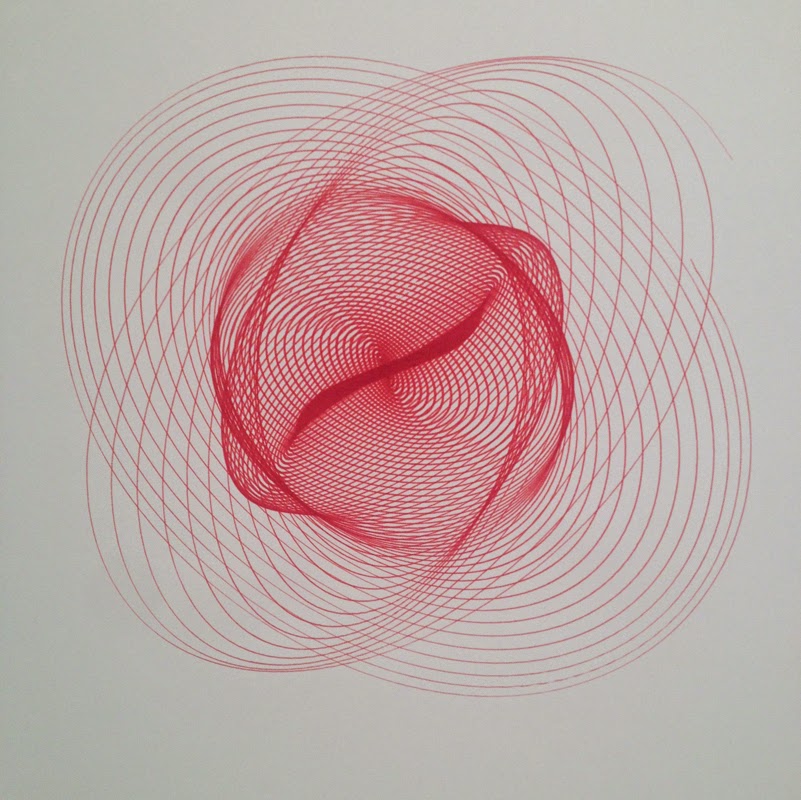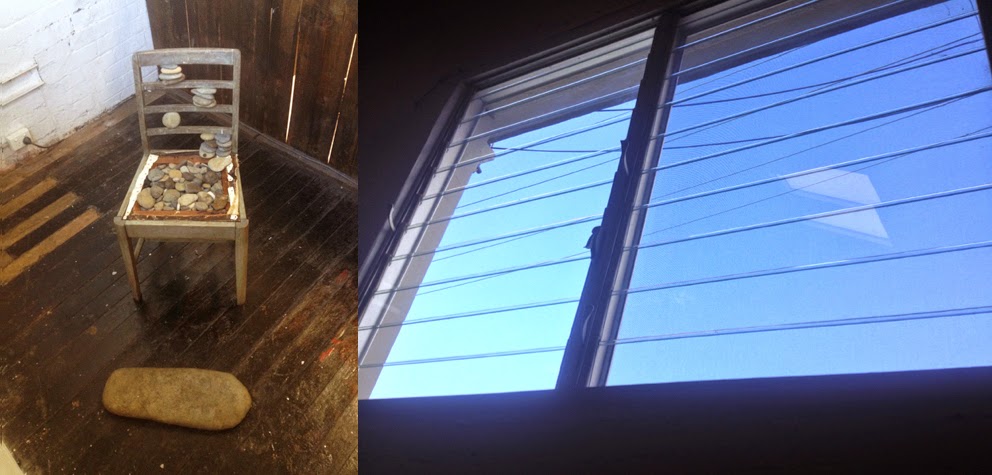The opening of FERAL 5
last week marked the closure and final ripening of the FERAL project at Articulate project space. Some works in the final
iteration had a marked temporality appropriate to the progressive nature of the
exhibition as the relentless cycling and changing of works and artists over the
weeks had created something like an ecosystem within the enclosed hothouse of
the project space. An online dictionary states helpfully that like spatial position, temporality is an
intrinsic property of the object[i]. The idea
that time is as intrinsic a quality as space for occupation by FERAL art objects is interesting to consider.
Time is an active element addressed in many of the works, and it is also experienced
in the organic serial evolution of the show from week to week. Each week, not
just the artists but an audience of viewers returns to the space, armed with
memory and knowledge, to view that which has replaced that which has gone
before.
Time, and the action of time as human hair growth had revealed
itself as an integral part of Veronica Habib’s work I Love What You Have Done With Your Hair between weeks 3 and 4. Thickening
patches of hair on female underwear suspended at eye level suggested a body
that had matured over time, gaining in confidence and assertiveness. The cruel
machinations of time were also evident in the aging of Dominic Byrnes’ work, Trigger Warning. This work had altered
dramatically between shows. Last week it was quietly unobtrusive, an inane
white canister silently issuing pepper spray from its unobtrusive corner site in
intermittent blasts of quiet aggression. As penance, this week its evidently
unsafe actions had been encased in a plastic box which over time had become
aged and scarred by the ejaculatory miasma, evidence of which had pooled within
it, dripped down the wall and collected beneath in nasty brown stains.
In looking across these works we see time as a factor interacting
with and upon the works in natural processes (hair growth) as well as unnatural
processes (toxic waste containment), providing a commentary engaged with contemporary
life, and more particularly, questioning our desire for a state of fragranced
hairlessness. However, where the passing of time has the effect of inducing a
familiarity with objects, a curious anthropomorphic response results. Viewers
of Jeff Wood’s work Painting Machine exclaim
over the mechanised toothbrushes once they start their stuttering painting
action, and Jeff himself paternalistically ushers them gently back on to the
painting surface when they vibrate askance on to the gallery floor.
21.10.2014 is a
work about temporality on several levels: there is a performative aspect of the
work unfolding in the present time, yet it is also the date on which a drawing
was made and a death of a public figure occurred. Time is integral to the
discipline of process by which the work was made. The text itself evokes
collective social memory of a particular time in our history. Throughout the
space on opening night, various people wore t-shirts depicting t-shirts
declaring It’s time. This work is
part of a time-based project by Maryanne Coutts[ii].
Throughout 2014 Maryanne made a daily watercolour work depicting only the clothes
of a person appearing in a news report published that day. The t-shirt depicted
carries the words of Gough Whitlam’s campaign slogan and the date marks the day
of his death last year.
Memory and time, both personal and the ecological is evoked
by Louise Morgan’s work Senescence. Louise
is an artist concerned to draw attention to biodiversity loss and mass
extinction as a contemporary dilemma.[iii]The title
is a reference to the biological
process of cellular aging and the work depicts an array of painted paper
objects pinned to the wall in a poignant, saturated colour evocation of Louise’s
childhood memories of the leaf litter of a forest floor. These fragile paper
objects remind us of the immensity of evolutionary time.
Time is frequently described visually as a linear tracing of
chronological action, and in FERAL 5 a
number of installation works take the line into the project space. Remaining in
the show from Feral 4 Sarah Fitzgerald’s Arch
launches from the wall and into the space gracefully, its apparent motion
arrested by a house brick. Fiona Kemp’s work Tumble Turn references the black lines marking swimming pools,
which measure one’s progress up and down the lanes and continuing the analogy
of time as motion in the form of the curving on-itself tumble turn. If time is
represented by the linear form of Alexandra Sideris’ twisted and teased mild
steel sculptures, it is not the as expected measurable stop-start linear
progression but a unified loop, of bent circularity returning on itself.
Joe Wilson’s work Painting
in transit is a timber installation in which a wheeled crate of treated
timber is poised in an ambiguous state of stillness, counterpoised against a
ramp, appearing to have just stopped moving. The pause and solemnity of the
frozen moment of transit, of some unknown journey towards, or from, painting is
a provisional, between-time concept. The gravity of paused time is enhanced by
the meticulous craftsmanship of its construction.
The portrait tradition is one that traditionally explores
with the notion of time by its memorialisation of subject. While photography is
a medium by which this representation could be factually documented for
posterity, James Needham-Walker’s work expresses a more elastic approach to
time. Here, James depicts himself within the frame as ephemeral subject – as it
is a still from a past performance – yet the highly reflective gloss paper
print mimics the surface of a screen, anchoring us in a self-reflexive present
where the individual is blurred into fleshy facelessness. James writes, The screen is translucent, homogenising everything,
revealing nothing. There is no heightened understanding, rather, we are left
with the reflection of our own gaze. We are our own witness.[iv]
An engagement with the temporal as well as the spatial possibilities
of making, performing and presenting works has meant that much of the FERAL Exhibition has challenged the
static gallery model for the display rather than interaction with artworks. At
the same time, the curatorial model of communal studio has enabled an
engagement between artists, viewers and the time in which we live.
List of Works
Veronica Habib, I Love What You Have Done With Your Hair,
Underwear Brief, G-string and Dress,
2015, Suspended clothing, human hair
Dominic Byrne, Trigger Warning, 2015, timed air
dispenser, home-made pepper spray
Jeff Wood, Painting Machine, 2014
Maryanne Coutts, 21.10.2014, 2015, commercially printed
t-shirt
Louise Morgan, Senescence, 2015, watercolour on paper
Sarah Fitzgerald, Arch, 2015, MDF, acrylic paint, brick
Fiona Kemp, Tumble Turn, 2015
Alexandra Sideris, Supply 15, 2013, mild steel,
microcrystalline was, pigment
Joe Wilson, Painting in transit, 2015, timber
James Needham-Walker, Witness #1, framed digital photographic
prints on gloss paper, 76 x 76 cm
Images by Articulate Project Space and Lisa Sharp.
Endnotes









































